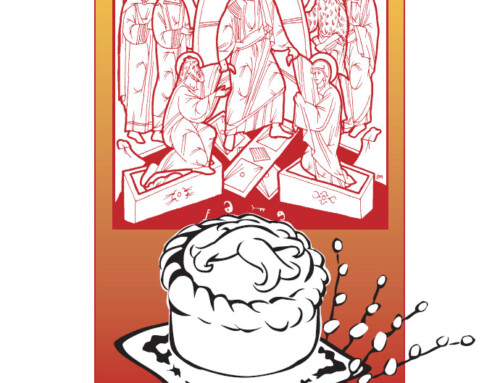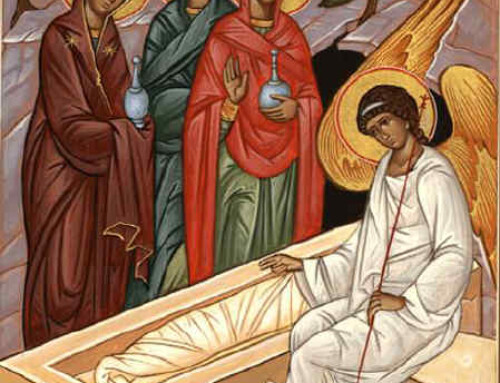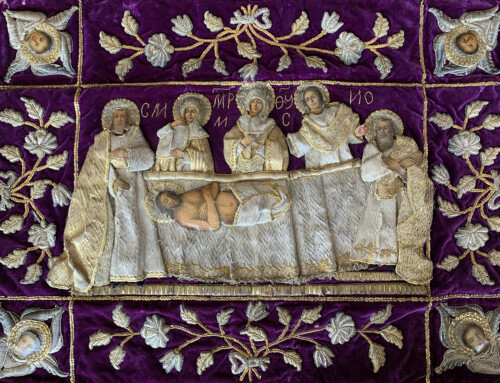Catechetical Sermons on the Divine Liturgy
#2 Before the Curtain Goes Up – the Proskomide (A.K.A., Proskomedia), or Prothesis
If we want to invite guests to our home we usually tell them what to expect: “drop by for coffee,” or lunch, or dinner or a bigger celebration, like a birthday party. Sometimes an additional event is added to it, “come for dinner and you can see our wedding video afterwards,” or come for lunch and we can play Scrabble after it.” Obviously, we will need to prepare for the visit accordingly. We will have to shop and cook, and take stock of what we will need by way of drinks or snacks, depending.
The Divine Liturgy is not simply the Supper of the Lord, it is a banquet. A banquet usually includes speeches, or at least remarks. Similar celebratory meals usually follow a structure developed by the local or ethnic community. A barbeque is the most informal, and a wedding reception is usually the most formal, but all such gatherings allow for some flexibility. The term Divine Liturgy means “the people’s Godly work,” or “the holy work of the people.” Just as parents may arrange for a dinner to celebrate a child’s marriage, so the celebration of the Divine Liturgy is not a haphazard event; someone in authority needs to arrange it.
The most rudimentary of all food and drink must be prepared for this Divine Banquet: bread and wine. In the format of the Divine Liturgy we use today, the preparation of the food and drink—the bread and wine—is a private task done by the priest and deacon. Originally bread and wine was provided by someone, and left in a designated area where the gathering was held. In Jerusalem, Antioch, and early Byzantium, a prayer was said over these gifts just before they were brought to the Holy Table. The brining of the gifts was simple and straightforward (just like the Tridentine rite of the Latin Solemn High Mass, where the bread and wine are kept on a small table in the sanctuary and carried to the altar very simply). Even up to the beginning of the 8th century, various texts show that the prayers of the proskomedia were said either at the beginning of the Liturgy, or just before their transfer to the Holy Table. It is somewhat confusing. Today we are used to a certain uniformity in every parish in a diocese, but in the early Church there was a great deal of variety, even between parishes in the same city. For example, when a bishop serves today with the hieraticon (the bishop’s service book), he completes the proskomedia just before it is carried to the Holy Table by the presbyters and deacons, and then—moving across the sanctuary to the inside of the Royal or Holy Doors—he accepts the gifts from their hands. The original procession from somewhere else has been ritualized in a smaller procession of only a few steps from one place in the sanctuary to the Royal Doors.
Originally the bread was covered with a cloth (something Jews do to this day with the special challah, bread which is blessed for the Sabbath meal), but not the cup. Over time, a great deal of ritual and symbolism was invested in the proskomedia, and psalm verses and prayers were uttered in the act of cutting the bread, laying it upon the plate, when pouring the wine and water into the chalice, and when covering the individual utensils and then when covering the whole array. The use of incense came to be prescribed for this preparation, and most of this was in place by the time of the Emperor Justinian I and his great project dedicated on December 27, 537 AD, the Church of Agia Sophia, the Holy Wisdom. In the massive space of the basilica, the conveying of the bread and wine to the Holy Table became a high point of the ritual, a procession far more splendid than the entrance rite.
Today the proskomedia is a “self-contained” rite. It opens and closes with the usual formal beginning prayers and ending prayers,” probably because it was done in a place other than the sanctity, perhaps even a different building. So, what meaning does this private ritual for priest and deacon have for us? Bishop Bohdan Danylo instructed the pastors to perform the rite once or twice a year in full view of the people and to explain it to them. Simply being aware of the proskomide is useful, for it should make us aware that the highest act of our worship requires the input, the contributions, of many whom we do not necessarily see in church, like the farmers who produced the wheat and grapes, those who made the bread and wine—and not just in our time, but through the ages since Jesus told us to do again what he did at his Last Supper. The mere development of the intricate ritual of preparing bread and wine tells us that the eye of our soul can see marvelous things by the light of the Spirit in the smallest gestures and objects!




